 Society
Society

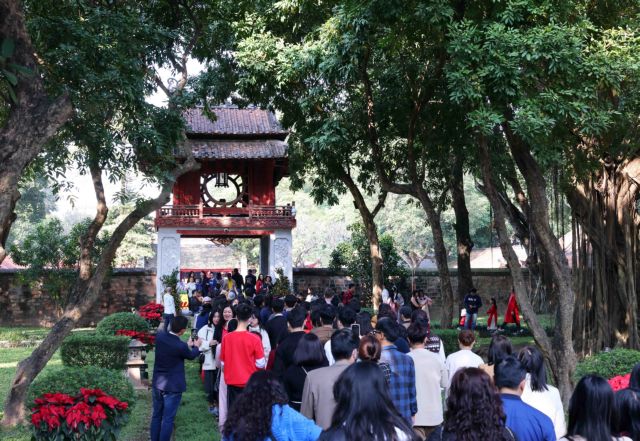 |
| Tourists visit the Temple of Literature in downtown Hà Nội during the Tết holiday. — VNA/VNS Photo Phạm Kiên |
Every Tết (Lunar New Year) holiday, as spring arrives, people all over the country eagerly participate in spring festivals and visit religious sites. This tradition has been preserved and developed over the years, becoming a beautiful feature of the new year.
Each festival has its own distinctive features and values, helping today's younger generation understand the great contributions of their ancestors to building and defending the nation, and take pride in their homeland and national traditions.
Festivals in Việt Nam are held across all regions, and are most vibrant in spring after the Lunar New Year holiday. Many large festivals have also become cultural tourism events, attracting hundreds of thousands of visitors.
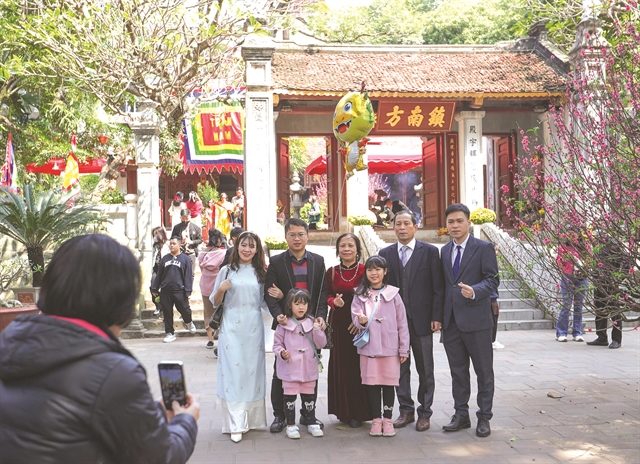 |
| Visiting religious sites and attending festivals have become a tradition for Vietnamese families in spring. — VNA/VNS Photo Hoàng Hiếu |
Việt Nam News introduces some of the main traditional festivals and religious heritage sites across the country that should not be missed this spring.
Hương Pagoda Festival
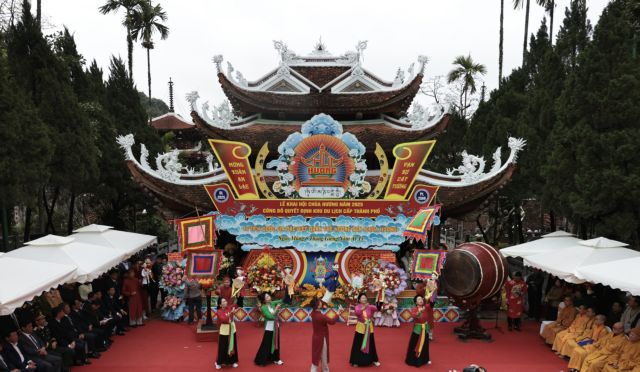 |
| A puppet performance at the opening ceremony of the Hương Pagoda Festival. — VNA/VNS Photo Trần Việt |
The Hương Pagoda Festival is one of the largest and longest festivals in Việt Nam. It takes place at Hương Sơn Commune in Mỹ Đức District on the outskirts of Hà Nội, and this year lasts from February 3 to May 1 (from the sixth day of the first lunar month to the fourth day of the fourth lunar month). This long duration allows visitors from all over the country to participate in the celebrations and enjoy the scenic beauty of the region.
Every year, the atmosphere of the festival creates a sacred and unique cultural experience that has been passed down for generations. Hương Pagoda, also known as the Hương Sơn Scenic Complex, is a vast religious and cultural heritage site consisting of numerous pagodas, temples and shrines.
The Hương Pagoda Festival embodies Việt Nam's rich religious and folk traditions. Built in the 17th century, the pagoda is closely linked to the legend of Princess Diệu Thiên, who practised asceticism for nine years in Hương Tích Cave before attaining enlightenment and saving all sentient beings.
The festival consists of two main parts: the ceremonial rituals and the festive activities. The rituals involve offering incense and prayers to the deities and spirits, expressing people's wishes for happiness and prosperity in the new year. As the Hương Sơn complex includes multiple places of worship, the rituals vary accordingly.
The celebratory part of the festival includes numerous traditional games and cultural activities such as boat racing, mountain climbing and folk performances like chèo (traditional operetta) singing and hát văn (spiritual singing). Visitors can experience the vibrant spring festive atmosphere while savouring local specialties from the Hương Sơn region.
On September 24, 2024, the Hà Nội authorities officially recognised the Hương Sơn Scenic Complex as a tourist site. To enhance visitor experiences and streamline management, Mỹ Đức District has made several reforms, including the introduction of e-tickets for site admission and boat transport.
A major highlight of the festival this year is the inauguration of the Hương Bình Cable Car Line, a 3km route connecting Hương Pagoda with Tiên Pagoda in Hòa Bình Province. The system, launched on February 1, has a transport capacity of 10,000 passengers per day, reducing travel time between the two sites to just 10 minutes.
Trần Temple Festival
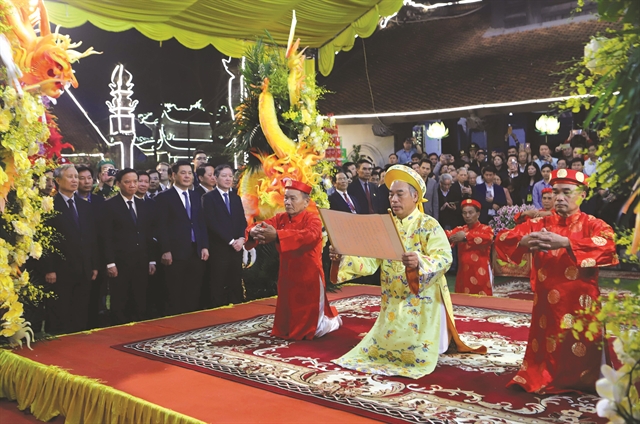 |
| A ritual of the Trần Temple Festival in Thái Bình Province. — VNA/VNS Photo Thế Duyệt |
Another major spring festival in the north is the Trần Temple Festival in Thái Bình Province, one of the biggest spring festivals in Việt Nam taking place over the next few days.
The event will be held from the 13th to the 16th of the first lunar month, or from February 10 to 14, attracting thousands of visitors in Hưng Hà District.
"This year's edition will be a special one as it will be the 800th anniversary of the reign of the Trần Dynasty (1225-2025). The provincial authorities and organisers have decided to make it big and memorable. We can't miss it," said Trần Mai Linh, a visitor from Hà Nội.
The festival was listed as a National Intangible Cultural Heritage in 2014 while the historical site of tombs and temples of the Trần kings was recognised as a special national monument.
This year will be the third time the festival is conducted on a provincial scale with all due ceremonials such as the temple opening ceremony, water procession ceremony, and incense offering ceremony.
A special music and dance programme will be organised on the opening night on February 10 in which performances rich in art and historical significance promises to leave a deep impression for spectators.
During the five-day event, visitors will have chance to take part in unique folk games and traditional activities such as wrapping bánh chưng (square sticky rice cake) contest and fish-feast cooking competition.
In particular, a hát văn (spiritual singing) programme – a unique art form associated with the belief in Mother Goddess worship – will be held at the venue, enriching the cultural and spiritual value of the festival.
"This is an important traditional cultural event held every year to commemorate the merits of the Trần kings and our predecessors in the cause of building and protecting the country," said Trần Hữu Nam, secretary of Hưng Hà District's Communist Party Committee.
"This is also an opportunity for people to understand values of national history and culture, express national pride and the desire to build and protect the homeland."
Temple of Literature
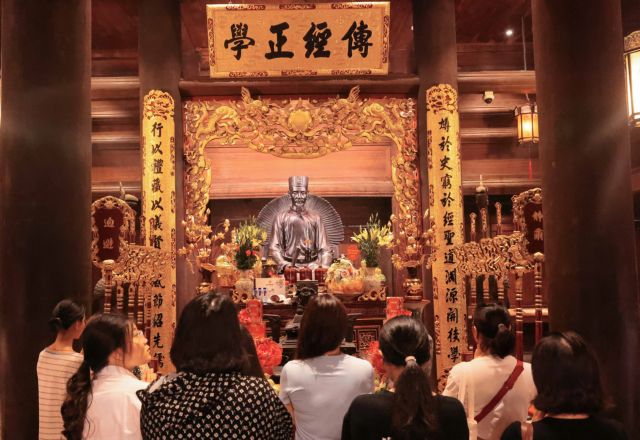 |
| The statute of Master Chu Văn An in the Temple of Literature. — VNA/VNS Photo Hoàng Hiếu |
In the first days of the Lunar New Year, Vietnamese line up to pay tribute to the masters of education in the Temple of Literature in central Hà Nội. Built in 1070 under the Lý Dynasty, the temple was dedicated to Confucius and honours the principles of Confucianism.
In 1076, four years on the throne, King Lý Nhân Tông founded the National College for Princes beside the Temple of Literature. It was the first college of Việt Nam, reserved only for royal princes and lords, children of the high-ranking court officials to study.
In 1253 King Trần Thái Tông changed the purpose of the Royal College, opening its doors to children of common people, who excelled in their studies. The college became a shining gem attracting great talents from all walks of life to study and hone their literary skills.
Under the reign of King Trần Minh Tông, Master Chu Văn An was appointed to be the Rector of Royal College and he himself taught the princes. When he died in 1370, the King Trần Nghệ Tông allowed to set up an altar to worship him in the Temple of Literature besides Confucius.
The Temple of Literature in Hà Nội still serves as the honourable place, where on the third day of a new Lunar New Year, parents and students often go there to pray for good luck in studies and exams.
Xích Đằng Temple
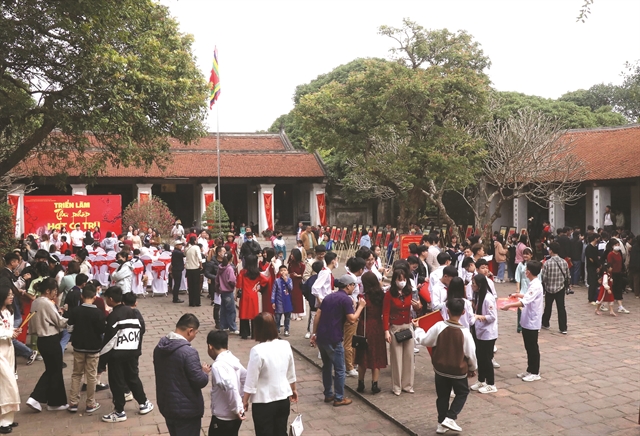 |
| The Xích Đằng Temple of Literature is a must-visit in Hưng Yên Province this spring. — VNA/VNS Photo Đinh Văn Nhiều |
Those who travel to Hưng Yên Province south of Hà Nội can also visit another younger Temple of Literature in Xích Đằng Village. Only one hour and a half from Hà Nội by car, a trip to the Xích Đằng Temple of Literature can be a one-day tour.
Located by the Red River, the temple plays a vital role in a larger historic site of Phố Hiến in Hưng Yên City. Built in the 17th century under the Lê Dynasty, the Temple of Literature in Xích Đằng Village was a modest structure until it was enlarged in 1839 under King Minh Mệnh to its today's size and shape.
During its more than 400-year history, Xích Đằng was the second oldest of its kind in the country and 161 grand laureates' names were inscribed on the steles in Xích Đằng Temple, a land that was dubbed second only to the royal citadel of Thăng Long, i.e. today's Hà Nội.
In the 17th century, King Lê Thánh Tông established many other schools besides the Royal College in Thăng Long in the provinces. These sites served as the worshipping places for the country's great scholars, and also served as the site for provincial exams heading to final court exams.
Like the Temple of Literature in Hà Nội, the Xích Đằng Temple also worships Confucius and Master Chu Văn An.
Spring has always been the season for activities honouring the master teachers and education. Fetching calligraphy, honouring the great masters of the country and nurturing the tradition that values training and education can be named among spring activities at the temple.
Sình Village Wrestling Festival
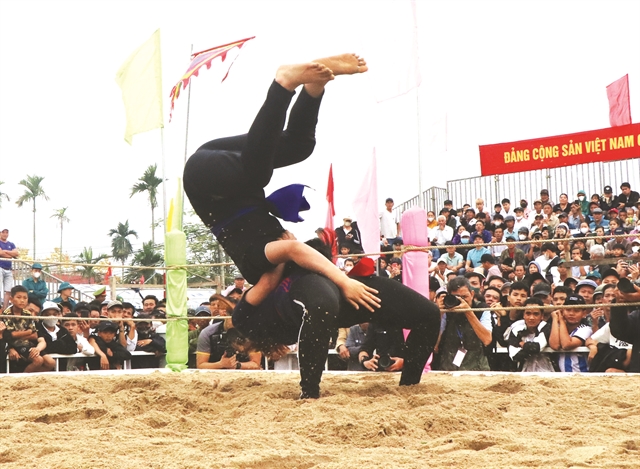 |
| The Sình Village Wrestling Festival is organised by as a form of entertainment during the Tết holiday.— VNA/VNS Photo Tường Vi |
The Sình Village Wrestling Festival is held annually on the 10th day of the first lunar month at the communal house of Lại Ân Village, also known as Sình Village, in Phú Mậu Commune, Phú Vang District in the central province of Thừa Thiên Huế.
The festival consists of the ceremonial part and the festive part, and it takes place just one day. The ceremonial part is held solemnly at the communal house of Lại Ân Village, during which the village elders perform rituals to pay respects to the guardian saint of the village. After that, the main festive activities begin.
The 400-year-old festival is organised by the locals as a form of entertainment after the Tết holiday. One of its distinctive features is that any spectator can register to participate. According to village regulations, wrestlers do not necessarily have to be locals; any audience member can step onto the wrestling mat to compete.
Huỳnh Lanh, a Sình villager, said the locals enjoy watching the festival while welcoming friends and visitors from near and far.
“According to local customs, every year we hold the wrestling festival traditionally to promote health among the young men and to foster prosperity. We pray for favourable weather and good harvests. Maintaining this tradition year after year keeps the atmosphere lively and vibrant,” he said.
Bà Đen Mountain
In the past few days, stunning aerial photos capturing a sea of people seated on picnic mats at the foot of Bà Đen (Black Lady) Mountain in the southern province of Tây Ninh have taken social media by storm.
Thousands of pilgrims and tourists have flocked to one of the South's most famous tourist spots on the fourth day of the lunar new year – marking the opening day of the Bà Đen Mountain Spring Festival – for the largest pilgrimage season of the year.
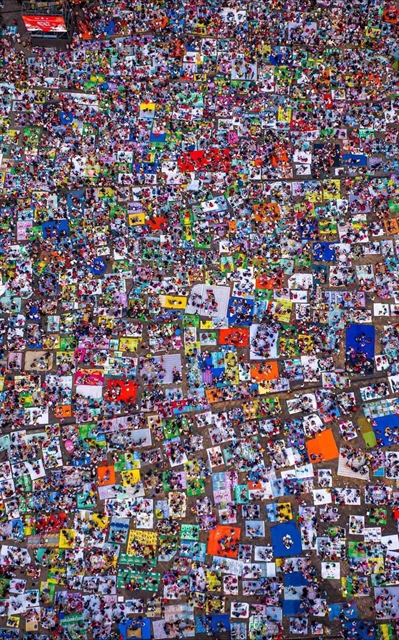 |
| An aerial photo featuring a sea of people seated on picnic mats at the foot of Bà Đen (Black Lady) Mountain on the opening day of the Bà Đen Mountain Spring Festival on February 1. Photo courtesy of Sun World Ba Den Mountain |
Standing tall on the outskirts of Tây Ninh City, Bà Đen Mountain is the highest peak in south Việt Nam proper. It is renowned for its majestic natural landscapes, magnificent caves, and sacred pagodas and temples. At the summit, visitors are greeted by the tallest statue of Buddha in Asia, standing on a lotus, alongside a 36m-high statue of Maitreya Buddha made from 6,688 sandstone pieces, and a Buddhist exhibition centre.
Bà Đen Mountain is a celebrated spiritual tourism destination, drawing a great number of domestic and international visitors for both sightseeing and worship.
Its beauty emerges and disappears among the white clouds, adorned with a complex of temples and pagodas from the base to the summit. It stands as a cultural and religious symbol of Tây Ninh Province, enticing those who love conquering majestic nature and serving as a sacred pilgrimage site for thousands of Buddhist followers each year.
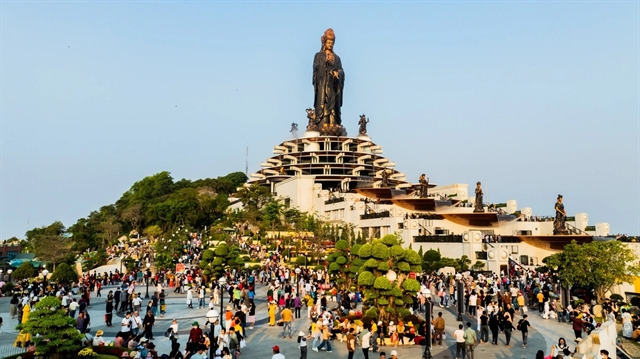 |
| During the five days of the Lunar New Year season, more than 540,000 visitors took the cable car to Bà Đen Mountain. Photo courtesy of Sun World Ba Den Mountain |
The Bà Đen Mountain Spring Festival is a unique cultural event in Tây Ninh. It lasts from the fourth to the sixteenth day of the first lunar month.
During the five days of the Lunar New Year holiday, 541,000 visitors took the cable car to Bà Đen Mountain. The sacred Bà Temple, associated with the legend of Linh Sơn Mother Goddess, along with magnificent spiritual structures and unique cultural experiences, has made Bà Đen Mountain the leading spiritual destination in the South this spring.
Throughout the festival, visitors are immersed in the festive atmosphere, rich in local colours, especially during lively dances performed by young ethnic Khmer women.
 |
| Young ethnic Khmer women perform lively traditional dances at the Bà Đen Mountain Spring Festival, which lasts until the 16th day of the first lunar month (this year falls on February 13). Photo courtesy of Sun World Ba Den Mountain |
The Di Lặc (Maitreya Buddha) Festival at the top of Bà Đen Mountain features the lantern offering ceremony on weekend nights from the full moon of January until the end of the spring festival.
Lighting flower lanterns at the summit at the beginning of the new year is a meaningful activity cherished by many Buddhist pilgrims and visitors. Thousands of lanterns illuminate the peak amidst the clouds, creating a magical and sacred space for visitors to send their wishes for blessings and peace in the new year. VNS




